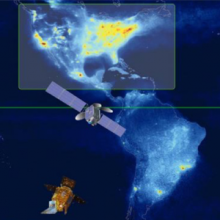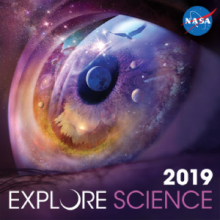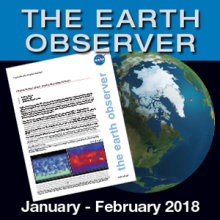- Home
- Missions
- Data
- Communications
- People
- The Earth Observer Newsletter




Recent Imagery
You will be directed to the NASA Visible Earth webpage when you select Images by Mission below, or click on the images at right that are randomly generated to represent four out of all possible topics.
Featured Content
 |
Jan-Feb 2019 issue of The Earth ObserverTo close out 2018, NASA’s Science Communications Support Office (SCSO) supported the NASA Science exhibit at the AGU’s Fall Meeting, held December 10-14, 2018, in Washington, DC. The booth featured NASA’s Hyperwall, a virtual reality space, a hands-on demonstration area, and a NASA Anniversaries area to celebrate the sixtieth anniversary of the agency. To learn more about the exhibit and NASA’s participation in the AGU Centennial Narratives Project, we invite you to read the January-February 2019 issue of The Earth Observer. |
 |
Nov-Dec 2018 issue of The Earth ObserverWe invite you to check out the November-December issue of The Earth Observer. The issue includes a report from the GEO-CAPE Air Quality Science Workshop, focusing on the Atmospheric Composition Virtual Constellation (AC-VC), whose goal is to collect and deliver data to improve monitoring, assessment, and model predictions for changes in the ozone layer, air quality, and climate forcing. The newsletter also includes updates from the DSCOVR mission, the 2018 Vector-Borne and Water-Related Disease Workshop, twenty-first OMI Science Team Meeting, thirtieth CERES Science Team Meeting, and 2018 Earth Radiation Budget Workshop. |
 |
The 2019 NASA Science Calendar is Now Available!At NASA’s Science Mission Directorate, our vision propels us to be purposeful and blur the lines between the present and future. From the first 60 years of NASA Science and into the future, our goal is to reach beyond what we know by investigating nature—the Earth, the Moon, the Sun, other worlds of our solar system, the countless stars and galaxies, and the universe—where we can learn more. The selected images in this calendar are nature’s art. Each is a moment in space and time that represents the efforts of many individuals committed to the scientific pursuit of knowledge and advancement of humankind. |
 |
2018 AGU: Schedule of Events at the NASA BoothAre you traveling to Washington, DC to attend the 2018 AGU Fall Meeting, held December 10-14, 2018? If so, we invite you to visit the NASA Booth in the Exhibit Hall. Learn something new, have fun, and discover together! |
 |
NASA’s DEVELOP Program Recognizes 20 Years of Science Serving SocietyNASA’s DEVELOP National Program, part of the Applied Sciences Program, is celebrating its twentieth anniversary this year. What began with three student interns in 1998 has evolved into a national program engaging hundreds of participants and partners each year. Turn to page 11 of the September-October 2018 issue of The Earth Observer to learn more about DEVELOP’s history and its 2018 Earth Science Application Showcase held at NASA Headquarters. |
 |
ICESat-2 Launches to Track Earth's Changing IceEarth's ice is shrinking. Retreating glaciers. Shrinking sea ice. Melting ice sheets. The frozen reaches of Earth are changing at dramatic rates—and the impacts, from sea level rise to altered weather patterns, span the planet. On September 15, 2018, NASA launched the Ice, Cloud and land Elevation Satellite-2 (ICESat-2) to measure changes in Earth’s ice and improve forecasts of the global impacts. ICESat-2 will use rapid-firing lasers to measure the height of Earth’s changing glaciers, ice sheets and sea ice, all in unprecedented detail. Read more about this extraordinary mission! |
 |
Nearly 20 Years of Daily Global MODIS Imagery at Your FingertipsNASA's Moderate Resolution Imaging Spectroradiometer (MODIS) is an extremely versatile instrument that has sometimes been called the “workhorse” of NASA’s Earth Observing System. As of June 2018, all daily global MODIS imagery dating back to the operational start of MODIS data collection in 2000 is available through NASA’s Global Imagery Browse Services (GIBS) and can be viewed rapidly and interactively using EOSDIS’s Worldview visualization application. We invite you to read the July-August 2018 issue of The Earth Observer to learn more about this effort, as well as other interesting news about NASA's Earth Science missions. |
 |
GRACE-FO Launches!The Gravity Recovery and Climate Experiment Follow-On (GRACE-FO) mission launched onboard a SpaceX Falcon 9 rocket, Tuesday, May 22, 2018, at 12:47 PM PDT (3:47 PM EDT) from Space Launch Complex 4E at Vandenberg Air Force Base in California. To learn more about GRACE-FO, see page 4 of the May-June issue of The Earth Observer. |
 |
A Trip Through The Earth Observer NewsletterThe Earth Observer has entered its thirtieth year as a NASA publication. The very first issue was in March 1989. Our archives are a veritable treasure-trove of history about the development of NASA’s Earth Observing System (EOS), the broader NASA Earth Science Research, Applications, and Flight programs, and related education and outreach activities. In the feature article on page 5 of the March-April 2018 issue, our Executive Editor takes us on a trip through The Earth Observer archives, no doubt stirring memories in readers who were part of these events. For all our readership, we hope that a better appreciation for the past helps inform our present and future endeavors. |
 |
Starting a New Year: The Jan - Feb 2018 Issue of The Earth Observer NewsletterNASA will commemorate the 60th anniversary of its establishment later this year (2018), with various milestones being celebrated throughout the year. For example, January 31, 2018, marked the 60th anniversary of the launch of Explorer 1, the first U.S. space satellite. The January-February issue of The Earth Observer newsletter highlights results from an assessment of missions in extended operations, provides a status on recently launched assets that build on heritage missions, and reports on the release of recommendations for the prioritization of Earth science observations in the coming decade. The issue also highlights NASA’s recent outreach activities at the American Geophysical Union (AGU) Fall Meeting, and summarizes recent science meetings and workshops such as the Interagency Workshop on Societal Applications of Satellite Data for Ocean Health and Fisheries. |
